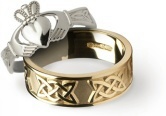Blog Categories
Blog CategoriesThe Vikings in Ireland
The Vikings had a profound influence on many cultures in Europe, including that of the Irish. Ireland actually enjoyed a fairly long period during which it was free from foreign intervention. However, in 795 the Vikings invaded Lambay Island in Dublin Bay. This was the beginning of several hundred years of conflict that would have a strong impact on Irish culture.
The Vikings were divided into two main groups, the Danish and the Norwegians. At first, the Vikings simply raided Ireland to plunder the wealth of the monasteries and churches and anywhere else they could find items of value. Eventually, however, the Vikings began to establish permanent settlements in various locations in Ireland. These included the ports of Dublin, Cork, Limerick, Waterford and Wexford. These Viking settlements helped to establish the first large towns and cities in Ireland.
The Vikings gradually became involved in wars between Irish clans. In 1014, Brian Boru, the first man to be named High King of Ireland, united a large army composed of many of Ireland's warring clans. Together, they managed to inflict a major defeat on the Vikings, whose power was effectively ended in Ireland. However, many Vikings had already assimilated into Irish culture, so their influence on the culture was permanent.
One of the ways we can see how the Vikings influenced the Irish was in the design of jewelry and crafts. Viking and Celtic designs are in many ways complementary, and the two have merged quite a bit over the centuries. Strong evidence of this was found during the archeological excavations at Wood Quay in Dublin between 1974 and 1981. The Viking settlement that was discovered here dates back to around 950 AD.
| Our Viking Collection, inspired by the find at Wood Quay | ||
 |
 |
 |
Although the Vikings were eventually driven out of Ireland, their influence on the land was significant. They helped to create some of Ireland's earliest towns, intermarried with the local population and had a powerful impact on local arts and craftsmanship.
